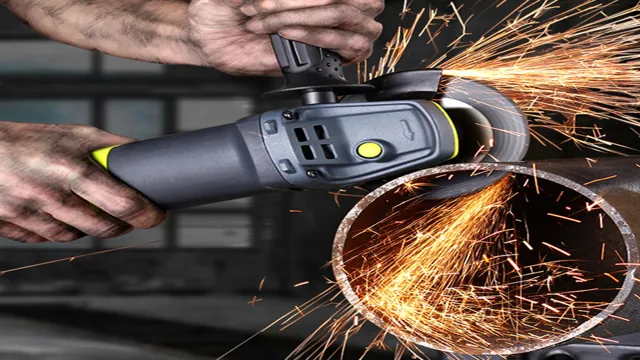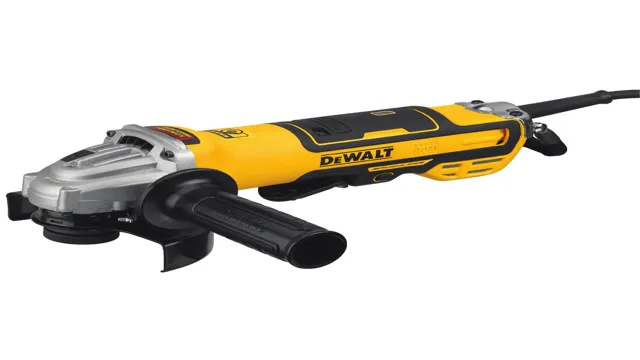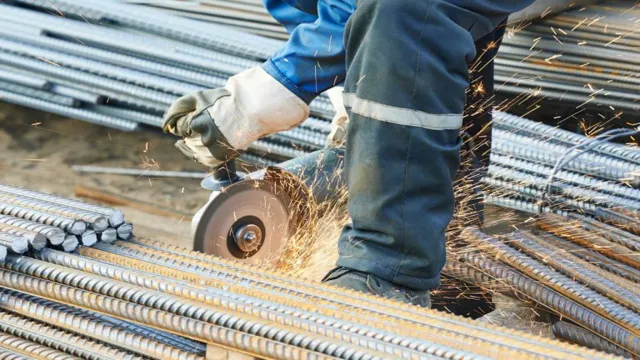
Do you need to cut metal but don’t have the right tools? You may be wondering if an angle grinder can do the job. The answer is yes, an angle grinder can cut through metal, but it’s important to use the right blade and take safety precautions. An angle grinder is a versatile tool that can be used for various tasks, including cutting, grinding, and polishing.
It’s a handheld tool that uses a spinning abrasive disc to cut through different materials, including metal, wood, and concrete. However, it can be tricky to cut metal with an angle grinder, so keep reading to learn more about the process and what you should keep in mind.
Understanding Angle Grinders
Yes, an angle grinder can cut metal. Angle grinders are powerful tools that can handle a variety of tasks, including cutting, grinding, and polishing. When using an angle grinder to cut metal, it is important to take safety precautions to avoid injury.
Make sure to wear protective gear such as gloves, safety glasses, and a face shield. The blade used for cutting metal should also be chosen carefully, as it needs to be strong enough to cut through the metal without breaking or wearing down quickly. Overall, with the right blade and proper safety measures, an angle grinder can be a highly effective tool for cutting metal.
What is an Angle Grinder?
Angle Grinder An angle grinder is a versatile power tool used for cutting, grinding, and polishing a variety of materials. The tool is called an angle grinder because it has a head that is fixed perpendicular to the body of the tool at a 90-degree angle. The grinder’s motor spins the head at varying speeds, depending on the job at hand.
Angle grinders come in a variety of sizes and power ratings, and they can be used for a wide range of tasks, from cutting metal pipes and tiles, to grinding off old paint or rust from metal surfaces, to polishing surfaces to a smooth finish. These power tools are widely used in construction, metalworking, woodworking, and automotive repair industries. It’s important to use an angle grinder safely, always wearing safety glasses and proper personal protective equipment, and to follow the manufacturer’s instructions on its use and maintenance.

How Does it Work?
Angle grinders are versatile power tools used for cutting, grinding, and polishing a variety of materials like metal, concrete, and tile. They consist of a motor, a disc, and a handle. The motor rotates the disc at high speeds, enabling you to work on the material you’re cutting or shaping.
Angle grinders come in different sizes and shapes, ranging from small handheld models to large industrial machines. Their uses are diverse, from cutting tiles and steel pipes to removing rust and excess mortar. They can be fitted with different types of discs, depending on the task at hand.
For example, diamond discs are perfect for cutting through tough materials like concrete and granite, while wire brush discs are ideal for cleaning and rust removal. When using an angle grinder, it’s important to wear protective gear like gloves and goggles and to follow proper safety precautions to avoid injuries.
Types of Angle Grinders
Angle grinders are a versatile tool that can be used for a variety of tasks, from cutting through metal and concrete to sanding and polishing. There are two main types of angle grinders: corded and cordless. Corded grinders are connected to a power outlet and are generally more powerful and durable than cordless grinders, which are powered by rechargeable batteries.
Additionally, angle grinders come in a range of sizes, from small 4-inch models to larger 9-inch grinders, each designed for specific tasks. When choosing an angle grinder, consider the type and size of the job you will be performing, as well as your personal comfort and experience with the tool. It’s crucial to read the user manual carefully and follow safety precautions to prevent accidents.
Regular maintenance and replacement of worn parts are vital to ensure that your angle grinder works efficiently and safely. Remember, purchasing a quality angle grinder can truly make a difference in the effectiveness of your work.
Cutting Metal with an Angle Grinder
Can an angle grinder cut metal? Yes, an angle grinder can be a fantastic tool to cut metal. Its high speed and power make it ideal for cutting through thick sheets of steel, slicing through rusted bolts, and shaping metal pieces with ease. However, it’s important to use the right type of blade for the task.
A metal cutting disc is essential when working with metal, and it should be chosen based on the type and thickness of the metal you’re working with. Make sure to wear protective gear, such as safety glasses and gloves, and use clamps to secure the metal piece in place before starting to cut. Keep in mind that the angle grinder can produce sparks and dust, so work in a well-ventilated area to prevent a fire hazard.
With the right precautions, an angle grinder can be an effective and efficient tool for cutting metal.
Choosing the Right Disc
When it comes to cutting metal with an angle grinder, choosing the right disc is crucial. Not all discs are created equal, and using the wrong one can result in a dangerous situation. The most common discs for cutting metal are abrasive and diamond discs.
Abrasive discs are suitable for cutting soft or thin metals, while diamond discs are designed for thicker or harder metals. It’s essential to match the disc’s maximum speed rating with the angle grinder’s maximum speed to avoid accidents. Additionally, the thickness of the disc must match the thickness of the metal.
Using a disc that is too thin for the metal being cut can cause it to wear out faster, while a disc that is too thick will not cut effectively. Overall, it’s essential to consider the type of metal and the size of the job before selecting a disc to ensure a safe and effective metal cutting experience.
Preparing the Metal for Cutting
When it comes to cutting metal, using an angle grinder can be an effective and efficient method. However, before you start cutting, it is important to properly prepare the metal. This includes removing any rust, dirt, or debris that may be on the surface.
You can use a wire brush or sandpaper to do this. It is also important to ensure that the metal is securely clamped or held in place before starting to cut. This will prevent the metal from moving or vibrating during the cutting process, which can lead to a less precise cut or even injury.
Remember to always wear appropriate safety gear, such as gloves and eye protection, when using an angle grinder to cut metal. By properly preparing the metal and taking necessary safety precautions, you can ensure a successful and safe cutting experience.
Ensuring Safety
When it comes to using an angle grinder to cut metal, there are a few important safety measures you should keep in mind. First and foremost, always wear proper protective gear like gloves, goggles, and earplugs to prevent any injuries. It’s also essential to inspect the tool before each use and ensure that the blade is securely attached and in good condition.
Another crucial aspect to consider is the positioning of the grinder, ensuring that it is held securely and not at risk of slipping or sliding while in use. Finally, it’s important to always cut away from yourself and to avoid holding the metal with your hands or feet. By following these safety measures, you can effectively and safely cut metal with an angle grinder.
So, before you get started on your next metal-cutting project, make sure to prioritize safety to avoid any unfortunate accidents.
Cutting Techniques
Cutting metal with an angle grinder is a handy skill to have for anyone working with metal. With the right blade and a steady hand, an angle grinder can quickly and efficiently cut through all sorts of metal surfaces. It works by spinning a small, abrasive disc at high speeds, allowing it to grind through the metal with ease.
When using an angle grinder, it’s important to take the right safety precautions, as sparks and metal shavings can fly everywhere. Make sure to wear heavy gloves and eye protection, and keep a fire extinguisher nearby just in case. With a little practice, cutting metal with an angle grinder can become second nature, allowing you to tackle all sorts of projects with ease.
So grab your grinder and get to work!
Other Uses of Angle Grinders
Yes, an angle grinder can definitely cut metal. In fact, it’s one of the primary uses of this versatile tool. Angle grinders are perfect for cutting through thick metal plates, pipes, and rods.
You can also use them to remove rust from metal surfaces. Another common use of angle grinders is to grind down and smooth out rough edges on metal pieces. This is particularly useful if you’re working with welding or if you need to fit two metal pieces together tightly.
However, it’s essential that you wear appropriate safety gear when using an angle grinder. Always wear safety glasses and a face shield, as well as gloves and long-sleeved clothing to protect yourself from sparks and flying debris. It’s a good idea to work in a well-ventilated area, too, as angle grinders can generate a lot of dust and fumes.
Overall, a quality angle grinder is an essential tool for any metalworking workshop or DIY enthusiast.
Grinding and Polishing
Angle grinders are incredibly versatile tools that can be used for a wide range of applications. In addition to grinding and polishing, they can also be used for cutting through various materials, such as metal, tile, and concrete. Angle grinders are perfect for cutting through thick and tough materials that may be too difficult to cut through with manual tools.
They can also be used for removing rust, paint, and other coatings from surfaces. When used with the right attachment, angle grinders can also be used for sanding and smoothing wood surfaces. With so many uses, angle grinders are a must-have tool for any DIY enthusiast or professional tradesperson.
Removing Rust and Paint
Angle grinders are one of the most versatile power tools, and they have a variety of other uses beyond cutting and grinding. One of the most useful applications for angle grinders is removing rust and paint from metal surfaces. Angle grinders equipped with a wire brush attachment or an abrasive disc can quickly and easily strip rust and paint from metal, leaving a clean and smooth surface.
This is especially useful for restoring old metal objects like furniture, gates, and fences, which can accumulate rust and paint over time. Plus, using an angle grinder eliminates the need for manual labor, saving you time and effort. Overall, an angle grinder is an excellent tool to have in any DIY enthusiast’s toolkit since it can perform various tasks with ease.
Cutting Other Materials
Angle grinders aren’t just for cutting metal – they can also be used to cut a wide range of other materials. For example, with the right blade, an angle grinder can make quick work of cutting through concrete, brick, and stone. This can make it a great tool for DIY projects like laying a patio or building a stone wall.
Additionally, angle grinders can be used to shape and grind down wood, plastic, and other materials. However, it’s important to choose the right blade for the task at hand and always wear appropriate safety gear. With a bit of practice, an angle grinder can be a versatile tool that can make many DIY projects a breeze.
Conclusion
In conclusion, the answer is a resounding yes: an angle grinder can definitely cut metal! With its powerful motor and abrasive disc, it can slice through even the toughest of metallic materials with ease. So if you’re looking to make some precision cuts or chop up some scrap metal, don’t hesitate to reach for your trusty angle grinder – it’s sure to get the job done. Just be sure to wear appropriate protective gear and follow all safety guidelines, unless you want to end up with a totally different kind of metallic cut!”
FAQs
What diameter of cutting wheel should be used with an angle grinder to cut metal?
It is recommended to use a cutting wheel with a diameter of 4.5 inches or larger to effectively cut through metal with an angle grinder.
Can an angle grinder be used to cut through thick metal sheets?
Yes, an angle grinder with a proper cutting wheel can be used to cut through thick metal sheets. However, it may take more time and effort compared to using specialized tools for cutting thick metal sheets.
What precautions should be taken when using an angle grinder to cut metal?
It is important to wear proper protective gear such as safety goggles, gloves, and a face shield to avoid any injury. Additionally, the angle grinder should be securely mounted and the workpiece should be clamped firmly to prevent any accidents.
Can an angle grinder be used to cut stainless steel?
Yes, an angle grinder with a cutting wheel designed specifically for stainless steel can be used to cut through the material. However, it is important to ensure proper ventilation as cutting stainless steel can produce harmful fumes.
How do I choose the right cutting wheel for cutting metal with an angle grinder?
The cutting wheel should be designed for use with an angle grinder and for cutting through metal. It is important to choose a wheel with the appropriate diameter and thickness for the job, as well as the right type of abrasive material such as aluminum oxide or silicon carbide.
Can an angle grinder be used for precision cutting of metal?
While an angle grinder can be used for cutting metal, it may not provide the precision cutting needed for some applications. Specialized cutting tools such as a plasma cutter or laser cutter may be better suited for precision cutting of metal.
How do I maintain my cutting wheel and angle grinder for cutting metal?
It is important to regularly inspect the cutting wheel for wear and damage, and replace it as needed. The angle grinder should also be inspected for any damage or loose parts, and cleaned after each use to prevent debris buildup. Proper storage and handling of the equipment can also help prolong its lifespan.







